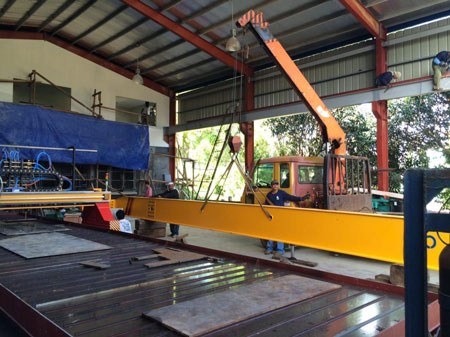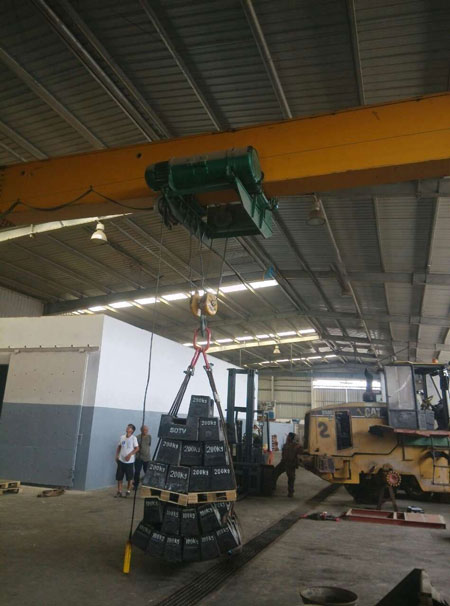Assembly and Installation of Single Girder Bridge Crane
Bridge cranes are widely used in various industries for efficient material handling. Single girder bridge crane is popular particularly due to their simplicity, versatility and cost-effectiveness. In this article, we will guide you through the process of assembling and installing a single girder bridge crane to ensure a smooth and successful installation.
Firstly, let's start by the details of installing a single girder bridge crane. The diagram below visually depicts the process. It includes clear illustrations and labels to help you understand each stage of the installation.

single girder overhead crane installation process
Now let's dive into the step-by-step process of assembling and setting up a single girder bridge crane. Please follow the following guidelines carefully to ensure a smooth and efficient setup:
Step1: Pre installation
Pre installation of the crane is required before the crane is actually installed. It ensures that the site and conditions are suitable for crane installation and makes the necessary arrangements for a smooth installation process. The pre installation phase usually includes the following:
Site assessment:
Evaluate site conditions, including footprint, load capacity and overhead clearance.
Ensure compliance with local regulations and safety standards.
Verify power availability and suitability for crane operation.
Crane Selection:
Determine the appropriate crane capacity, span and lifting height based on application requirements.
Select a reliable crane supplier that offers high quality single girder overhead cranes.
Foundation Preparation:
Excavate foundations according to manufacturer's specifications, considering soil conditions and load requirements.
Ensure anchor bolts are accurately aligned and positioned to match crane base dimensions.
Power and Utilities:
Ensure that the necessary power and utilities are available at the installation site.
STEP2: Assembly and Installation
The process mainly includes but is not limited to the following aspects, the order can be adjusted according to the actual situation:
ASSEMBLYING THE COMPONENTS:
Begin by unpacking the crane components and assembling them systematically. Check for any damage during transportation and report it to the manufacturer if necessary. Make sure that all necessary parts, including bolts, nuts and electrical components, are present.
INSTALLATION AND FIXING OF CRANE RAILS:
Accurately install the crane rails on site, ensuring that the rails are level and straight. Reserve expansion joints in the rails and fix them with cleats. Welded/bolted plates are also used for fixing.
INSTALL END TRUCKS:
First install end wheels at each end of the bridge girders. Follow manufacturer's instructions for proper alignment and connection. Ensure that the wheels are properly lubricated and aligned with the runway tracks or runway beams.
INSTALLING THE BEAMS:
Once the end trucks are securely in place, install the bridges on top of them. Use proper lifting equipment and follow safe lifting practices to avoid accidents or injuries. Properly align the crossbeams and securely fasten them to the end trucks using the fasteners provided.

FIXED ELECTRIC HOIST:
After securing the bridge girder in place, proceed to secure the crane to the girder at the specified location. Follow manufacturer's instructions for proper alignment and connections. Ensure that all electrical connections are secure and meet safety guidelines.
Attach Trolley:
Next, attach the cart to the bridge and ensure smooth horizontal movement along the length of the beam. Double check all connections and fasteners to avoid any potential problems during operation.
ELECTRICAL CONNECTIONS:
Once the mechanical components are in place, continue with the electrical connections. Connect power to the crane and trolley motors according to the wiring diagrams provided. Ensure that all connections are properly insulated and secured.

STEP3: Testing and final adjustments
After completing the assembly and electrical connections, thoroughly test the crane's functionality. Load testing is the most important part. It usually includes the following categories:
Static Load Test:
This involves testing the crane's ability to lift and hold a predetermined load without any movement. It verifies the structural integrity of the crane and ensures that it can safely handle the rated load capacity.
Dynamic Load Testing:
This category includes a variety of tests to evaluate the crane's performance under dynamic conditions. It includes tests such as accelerating, decelerating and stopping loads to evaluate the crane's stability, control and response to different operating scenarios.
Specific procedures may vary depending on crane design, capacity and applicable regulations. Performing a thorough load test ensures safe and reliable operation of the overhead crane.

Safety precautions during assembly and installation
Safety is a top priority during the assembly and installation of single girder cranes. All personnel involved in the installation process should wear appropriate Personal Protective Equipment (PPE), including helmets, goggles, gloves and shoes. Before operating any electrical components, disconnect the power supply and ensure proper insulation to prevent electrical hazards.
The assembly and installation of a single girder overhead crane requires careful planning, adherence to safety regulations and attention to detail. By following the step-by-step process outlined in this article, you can ensure the successful assembly and installation of an overhead crane for safe and efficient material handling operations in your facility. Regular maintenance and periodic inspections are critical to the continued reliability and safety of your crane.
For more specialized crane guidance, contact usnow! We are committed to providing customized solutions that fit your specific needs. Crane offers not only cranes, but a complete service including the provision of free quotations, installation and maintenance.
Frequently Asked Questions
Q: Can bridge cranes be customized to meet specific requirements?
A: Yes, overhead cranes can be customized to meet the specific requirements of different industries and applications. Manufacturers offer a range of options and configurations to meet different needs.
Q: Is there a weight limit for overhead cranes?
A: Yes, weight limits for overhead cranes depend on a variety of factors such as crane design, structural integrity and load capacity. It is important to consider these limits during planning and installation.
Q: How long does it take to assemble and install an overhead crane?
A: The time required to assemble and install an overhead crane may vary depending on factors such as the size and complexity of the crane, site conditions, and resource availability. It is best to consult the manufacturer or an experienced contractor for a more accurate estimate.
Q: Are there any legal requirements for operating overhead cranes?
A: Yes, there are legal requirements and regulations for operating overhead cranes. These regulations may vary by jurisdiction and industry. It is important to ensure compliance with these requirements to maintain a safe working environment.
- The last one:Casting Crane
- The next one:Truss Gantry Crane: Lifting Mechanism
 info@dejunindustry.com
info@dejunindustry.com +86 13721448067
+86 13721448067




